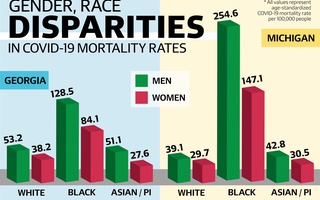{shortcode-657dfa866a3d121747bb44da7b16206a0c580d6e}
A January study from the Harvard GenderSci Lab found sex disparities for Covid-19 cases and mortalities vary widely across states and are likely driven by a variety of gender-related social factors.
The GenderSci Lab is an interdisciplinary team of scientists and gender studies scholars led by Sarah S. Richardson, professor of Studies of Women, Gender, and Sexuality. The paper represents “the first longitudinal study to quantify variation in COVID-19 gender/sex disparities across U.S. states,” according to the lab.
Lead author Ann Caroline Danielsen and other members of the GenderSci Lab utilized 55 weeks of data from their U.S. Gender/Sex Covid-19 Data Tracker to assess sex disparities in Covid-19 cases and deaths between April 2020 and November 2021. The lab’s data tracker reported information manually extracted from publicly available health department data.
The study revealed that cases have mostly been higher among women, possibly due to the fact that healthcare workers and pregnant people — both “overwhelmingly” women — are more likely to receive regular testing.
Aggregate data from the lab’s tracker showed a “modestly” higher Covid-19 mortality rate for men, meanwhile. But significant variations across states — and time — led researchers to conclude the difference in mortality rates across sexes was not based on biological factors alone.
“The heterogeneity in sex disparities documented by our research is consistent with the interpretation that gender-related social factors, which can vary across states, contexts, and social groups, drive COVID-19 sex disparities,” Danielson wrote in a blog post, co-authored by Amelia F. “Mimi” Tarrant ’22, on the GenderSci Lab site.
The post cited influential factors such as “gendered health behaviors,” “gendered occupational stratification,” and “gendered pre-existing conditions.”
“Biological sex-related factors are not adequate to explain the variation in sex disparities we observed,” Danielson and Tarrant continued. “When differences in COVID-19 outcomes between women and men are observed, as they are in our paper, interpreters should beware of rushing to conclude that the sex disparity is primarily caused by sex-related biological factors.
The study also pointed to policy decisions, such as the implementation of mask mandates and restrictions on businesses and schools, as an example of additional contextual factors made at the local and state levels. Other details to consider included the income levels, jobs, and races of those who died from Covid-19 during the timeframe of the study.
The paper concluded by encouraging future research to utilize the lab’s publicly available dataset in tandem with additional data to further explore “the effects of policy, investment, vaccine uptake, and other underlying structural inequities on sex disparities in COVID-19 outcomes.”
—Staff writer Jeremiah C. Curran can be reached at jeremiah.curran@thecrimson.com. Follow him on Twitter @jerryccurran.
Read more in News
Harvard Out of Occupied Palestine Protests Sabra Hummus in Harvard Yard















